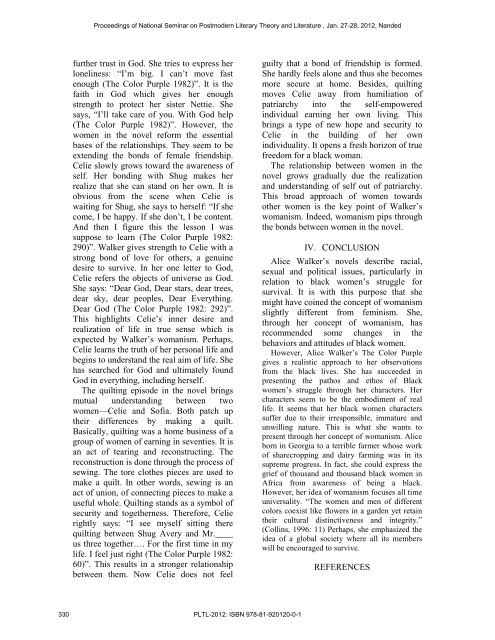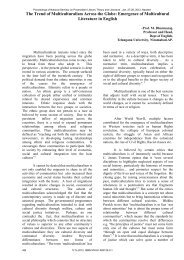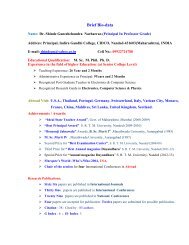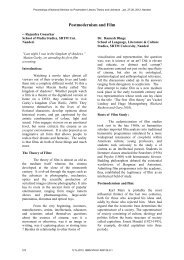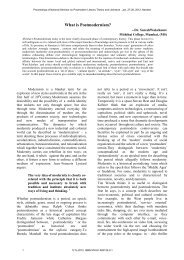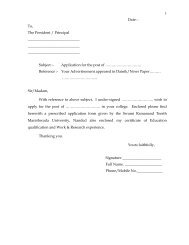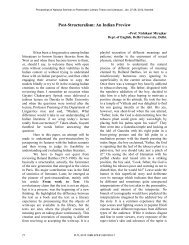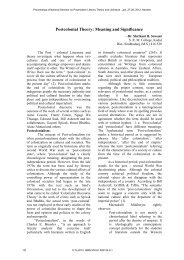Postcolonial Feminist Theory: An Overview - Igcollege.org
Postcolonial Feminist Theory: An Overview - Igcollege.org
Postcolonial Feminist Theory: An Overview - Igcollege.org
Create successful ePaper yourself
Turn your PDF publications into a flip-book with our unique Google optimized e-Paper software.
Proceedings of National Seminar on Postmodern Literary <strong>Theory</strong> and Literature , Jan. 27-28, 2012, Nandedfurther trust in God. She tries to express herloneliness: “I’m big. I can’t move fastenough (The Color Purple 1982)”. It is thefaith in God which gives her enoughstrength to protect her sister Nettie. Shesays, “I’ll take care of you. With God help(The Color Purple 1982)”. However, thewomen in the novel reform the essentialbases of the relationships. They seem to beextending the bonds of female friendship.Celie slowly grows toward the awareness ofself. Her bonding with Shug makes herrealize that she can stand on her own. It isobvious from the scene when Celie iswaiting for Shug, she says to herself: “If shecome, I be happy. If she don’t, I be content.<strong>An</strong>d then I figure this the lesson I wassuppose to learn (The Color Purple 1982:290)”. Walker gives strength to Celie with astrong bond of love for others, a genuinedesire to survive. In her one letter to God,Celie refers the objects of universe as God.She says: “Dear God, Dear stars, dear trees,dear sky, dear peoples, Dear Everything.Dear God (The Color Purple 1982: 292)”.This highlights Celie’s inner desire andrealization of life in true sense which isexpected by Walker’s womanism. Perhaps,Celie learns the truth of her personal life andbegins to understand the real aim of life. Shehas searched for God and ultimately foundGod in everything, including herself.The quilting episode in the novel bringsmutual understanding between twowomen—Celie and Sofia. Both patch uptheir differences by making a quilt.Basically, quilting was a home business of agroup of women of earning in seventies. It isan act of tearing and reconstructing. Thereconstruction is done through the process ofsewing. The tore clothes pieces are used tomake a quilt. In other words, sewing is anact of union, of connecting pieces to make auseful whole. Quilting stands as a symbol ofsecurity and togetherness. Therefore, Celierightly says: “I see myself sitting therequilting between Shug Avery and Mr.____us three together…. For the first time in mylife. I feel just right (The Color Purple 1982:60)”. This results in a stronger relationshipbetween them. Now Celie does not feelguilty that a bond of friendship is formed.She hardly feels alone and thus she becomesmore secure at home. Besides, quiltingmoves Celie away from humiliation ofpatriarchy into the self-empoweredindividual earning her own living. Thisbrings a type of new hope and security toCelie in the building of her ownindividuality. It opens a fresh horizon of truefreedom for a black woman.The relationship between women in thenovel grows gradually due the realizationand understanding of self out of patriarchy.This broad approach of women towardsother women is the key point of Walker’swomanism. Indeed, womanism pips throughthe bonds between women in the novel.IV. CONCLUSIONAlice Walker’s novels describe racial,sexual and political issues, particularly inrelation to black women’s struggle forsurvival. It is with this purpose that shemight have coined the concept of womanismslightly different from feminism. She,through her concept of womanism, hasrecommended some changes in thebehaviors and attitudes of black women.However, Alice Walker’s The Color Purplegives a realistic approach to her observationsfrom the black lives. She has succeeded inpresenting the pathos and ethos of Blackwomen’s struggle through her characters. Hercharacters seem to be the embodiment of reallife. It seems that her black women characterssuffer due to their irresponsible, immature andunwilling nature. This is what she wants topresent through her concept of womanism. Aliceborn in Ge<strong>org</strong>ia to a terrible farmer whose workof sharecropping and dairy farming was in itssupreme progress. In fact, she could express thegrief of thousand and thousand black women inAfrica from awareness of being a black.However, her idea of womanism focuses all timeuniversality. “The women and men of differentcolors coexist like flowers in a garden yet retaintheir cultural distinctiveness and integrity.”(Collins, 1996: 11) Perhaps, she emphasized theidea of a global society where all its memberswill be encouraged to survive.REFERENCES330 PLTL-2012: ISBN 978-81-920120-0-1


